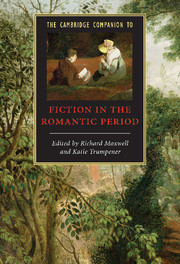Book contents
- Frontmatter
- Introduction
- 1 The historiography of fiction in the Romantic period
- 2 Publishing, authorship, and reading
- 3 Gothic fiction
- 4 The historical novel
- 5 Thinking locally: novelistic worlds in provincial fiction
- 6 Poetry and the novel
- 7 Orientalism and empire
- 8 Intellectual history and political theory
- 9 Women writers and the woman’s novel: the trope of maternal transmission
- 10 Tales for child readers
- 11 Sentimental fiction
- 12 Fiction and the working classes
- 13 The Irish novel 1800-1829
- 14 Scotland and the novel
- Further reading
- Index
- Series List
13 - The Irish novel 1800-1829
Published online by Cambridge University Press: 28 January 2009
- Frontmatter
- Introduction
- 1 The historiography of fiction in the Romantic period
- 2 Publishing, authorship, and reading
- 3 Gothic fiction
- 4 The historical novel
- 5 Thinking locally: novelistic worlds in provincial fiction
- 6 Poetry and the novel
- 7 Orientalism and empire
- 8 Intellectual history and political theory
- 9 Women writers and the woman’s novel: the trope of maternal transmission
- 10 Tales for child readers
- 11 Sentimental fiction
- 12 Fiction and the working classes
- 13 The Irish novel 1800-1829
- 14 Scotland and the novel
- Further reading
- Index
- Series List
Summary
Near the middle of Charles Robert Maturin's Melmoth the Wanderer (1820), the uncanny figure of Melmoth suddenly appears on the streets of seventeenth-century Madrid, prompting fearful but curious Spanish observers to wonder not only why he has not been seized by the Inquisition but if he has a known country of origin. “He is said to be a native of Ireland,” reports one, “- (a country that no one knows, and which the natives are particularly reluctant to dwell in from various causes).” In an important sense the Irish novel emerged in the early decades of the nineteenth century as an effort to remedy the strangely persistent situation defined in Maturin's throwaway parenthesis: to make familiar for both strangers and natives an unknown and unhomely land. “It is only with the last thirty years that the Irish have been very successfully represented,” T.H. Lister wrote in 1831 in an essay on “Novels Descriptive of Irish Life” for the Edinburgh Review, going on to explain that earlier representations had concentrated on isolated single figures in primarily English settings. Thus English readers never saw the Irish as a people or Ireland as a native land: “we never saw them grouped - we never trod with them on Irish ground.” Like most of his contemporaries, Lister credits this shift in representation to Maria Edgeworth whose first novel, Castle Rackrent (1800), was widely identified in the period as the inaugural moment of a distinctive Irish line of English-language fiction. It has retained this status ever since. Not that Castle Rackrent was the first novel written either from or on Ireland but that Edgeworth's fictions, along with those of her compatriot Sydney Owenson (better known in the period by her married name of Lady Morgan), mark the emergence in the British literary field of what Terry Eagleton has called “a whole distinctive object known as Ireland,” one that commanded attention in and for itself precisely because of its heightened “problematical” nature.
- Type
- Chapter
- Information
- The Cambridge Companion to Fiction in the Romantic Period , pp. 235 - 250Publisher: Cambridge University PressPrint publication year: 2008
- 1
- Cited by



